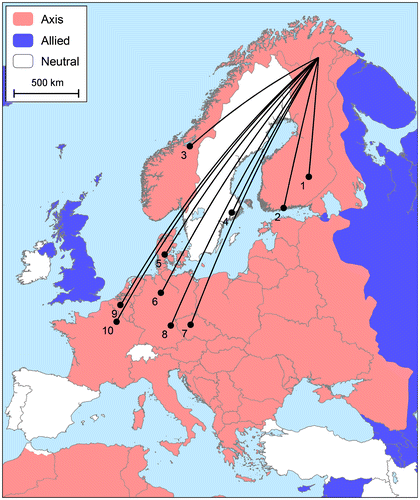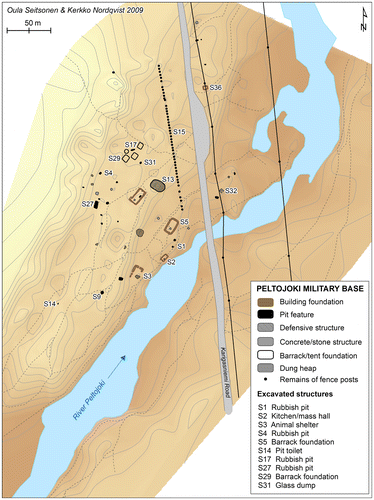Figures & data
Figure 1. Top: Location of the studied Peltojoki Military base in Lapland, and the frontlines in 1941–1944; Bottom: Present-day view over the Peltojoki base situated on the right bank of the River Peltojoki (Illustration: Oula Seitsonen).
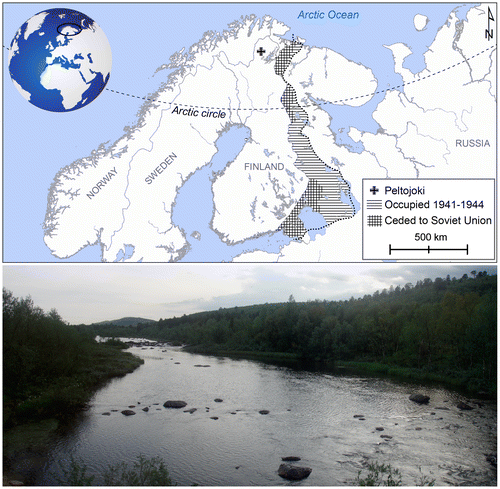
Figure 2. Left: Original caption: ‘Maintenance road on the west bank of the Kotikoski. Wagons part of a German supply train. / Traffic on the Alakurtti road’ (Photograph: Heikki Roivainen/SA-Kuva JSdia006/Alakurtti (Salla) 26.09.1941); Right: Original caption: ‘German “panzer lieutenant” as a fjell climber’ (Photograph: Heikki Roivainen/SA-Kuva 67457/Voittotunturi 15.12.1941).
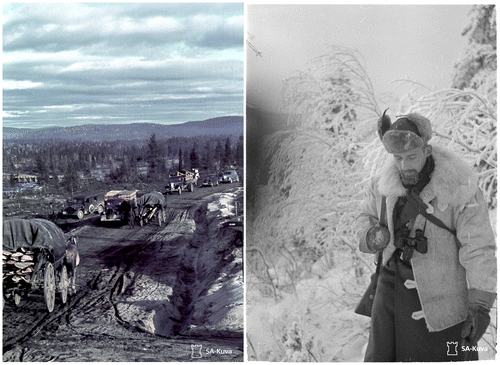
Figure 4. Some of the excavated structures: (a) Rubbish pit S1/trench 1; (b) Animal shelter S3/trench 3; (c) Kitchen-mess hall S2/trench 2a (Photographs: Oula Seitsonen); (d) Rubbish pit S27/trench 6, Oula Seitsonen digging (Photograph: Kerkko Nordqvist).
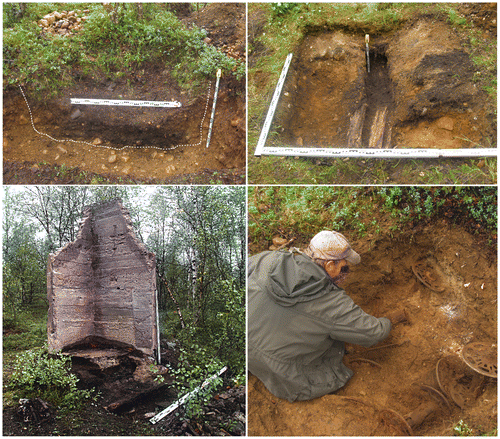
Table 1. Finds catalogued at the test excavations (x = present; Misc. category includes bits and pieces of e.g. charred leather, cloth and paper, metal, wire, and so on).
Figure 5. Top: Original caption: ‘Germans repair a maintenance road’ (Photograph: Heikki Roivainen/SA-Kuva 82313/Petsamo, Litsavuono 17.4.1942); Bottom: Mercedes-Benz 320 of the Second Gebirgsjäger Division (division insignia painted on the door) somewhere in the Lapland wilderness; Note the skis and ski poles attached to the bonnet and snow chains on the rear wheels, and the sticks set up along the roadsides as markers in the snow (Photograph: Max Peronius 1940–1944).

Figure 6. Top: Entrance road to the Peltojoki base as seen today: barrack foundations (S5) in the bush to the left and the single standing fencepost on the right (red and blue paint on the fence marks the start of a modern-day hiking trail); Bottom: Barrack foundations (S12) on the upper-terrace (Photographs: Oula Seitsonen).
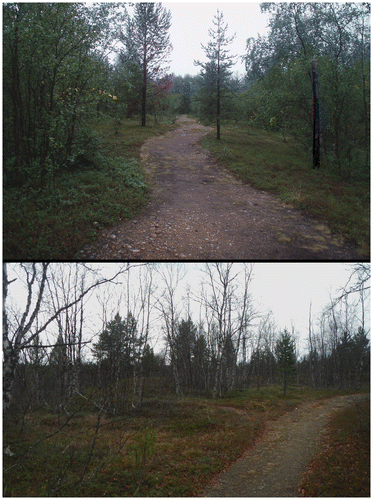
Figure 7. Top: Prefabricated barracks in a German camp somewhere in the Finnish Lapland (Photograph: Max Peronius 1940–1944); and sales brochure blueprints of the “yurt”-like plywood tents; Middle: ‘Tenda di legno compensato’ (Plywood tent; drawn by O. Seitsonen after Joh. Parviaisen tehtaat O.y., Citation1942); Bottom: ‘Kleinjurte’ (Small yurt; drawn by Oula Seitsonen after Puutalo Oy., Citation1943), targeted by the Finnish woodcraft industry especially to the German and Italian markets.

Figure 8. Household finds from the excavations: (a) refitted German cup, (b) refitted Arabia Pääsky jug, (c) German soup bowl fragment, (d)–(g) ceramic stamps, (h)–(l) cutlery, (m)–(q) tins, (r) fragment of a stoneware bottle, (s)–(t) cutlery stamps, (u) ‘RK’ scratched on a fork, (v) Delbeck bottle top, (w) Aktiebolaget Vin & Spritcentralen bottle top (10 cm scale: b–c; 5 cm scale: a, h–r; 2 cm scale: d–g, s–w) (Illustration: O. Seitsonen).
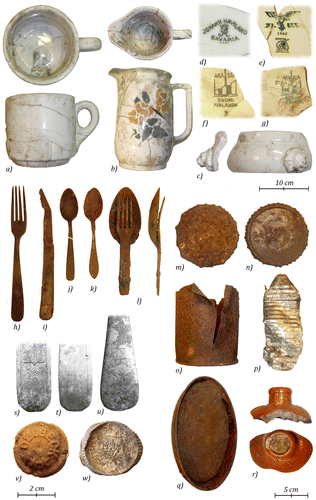
Figure 9. Building materials from the excavations: (a) melted box of nails (b) melted explosive rivets, (c–d) melted light bulbs, (e) coat hooks, (f) cupboard hinge, (g) makeshift oven door, made from a fuel drum lid (30 cm scale: g; 5 cm scale: all others) (Illustration: O. Seitsonen).
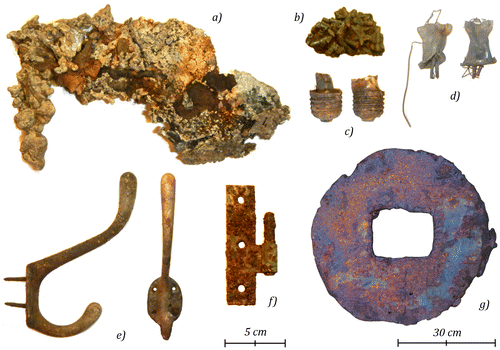
Figure 10. Military finds from the excavations: (a) pickaxe, (b) pile of melted mess tins, (c)–(d) shoe sole irons, (e)–(f) ski bindings, (g) gas mask filter, (h) burned binder, (i) tail of a 1 kg incendiary bomb, (j)–(n) shells, (o)–(u) German buttons, (v)–(x) buckles, (y) unidentified button, (z) ‘Oт Якoвa’, an engraved piece of aluminium, (å) self-made shoe sole with a wooden heel (10 cm scale: a–i; 5 cm scale j–å) (Illustration: O. Seitsonen).
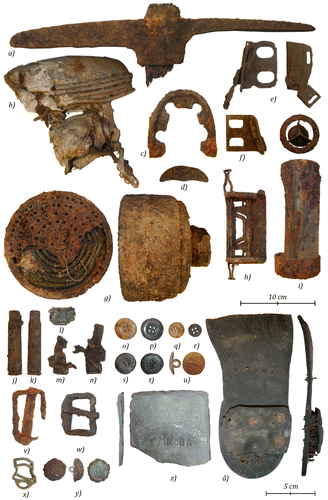
Table 2. Recovered finds by the origin and the manufacturers’ approximate Euclidean distance from the Peltojoki base.
Figure 11. Provenances of artefacts encountered at Peltojoki base (numbering refers to the Table ), and the maximum extent of Axis-related territories in 1942 (Note: modern borders) (illustration: Oula Seitsonen).
